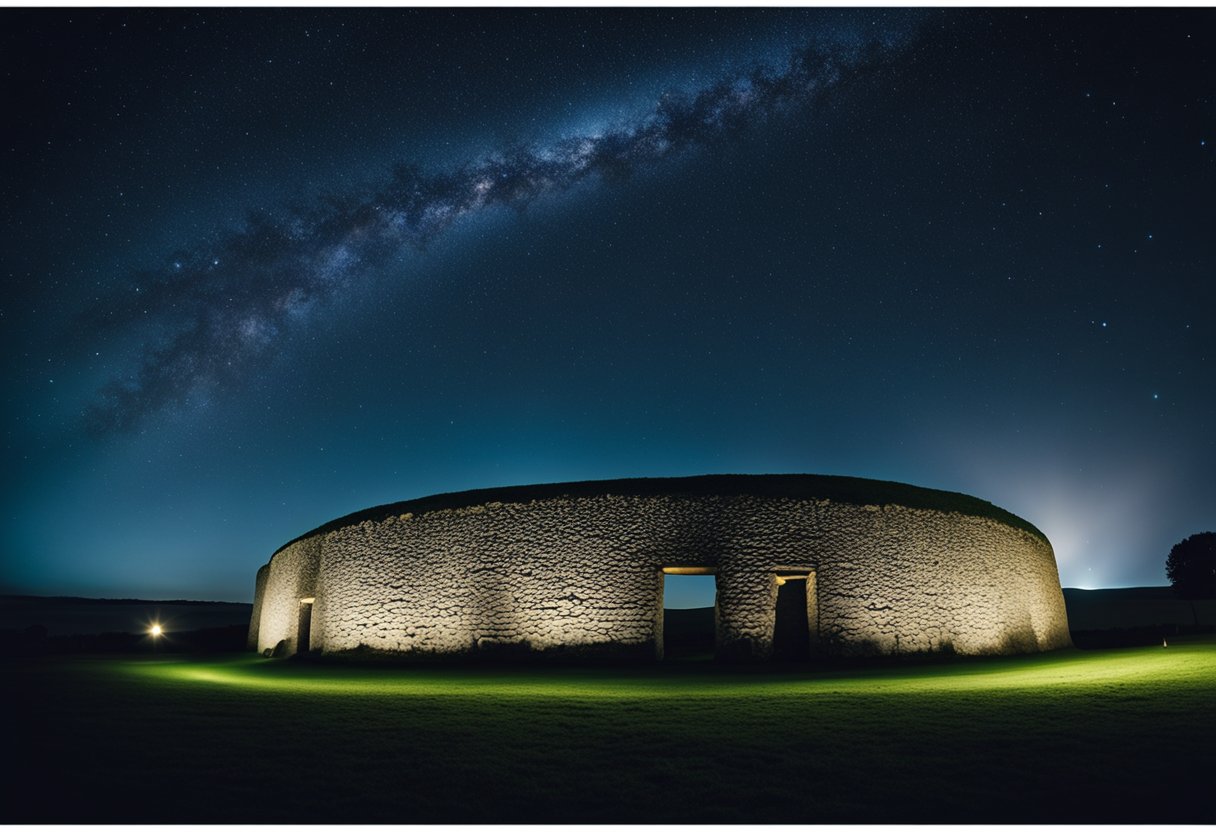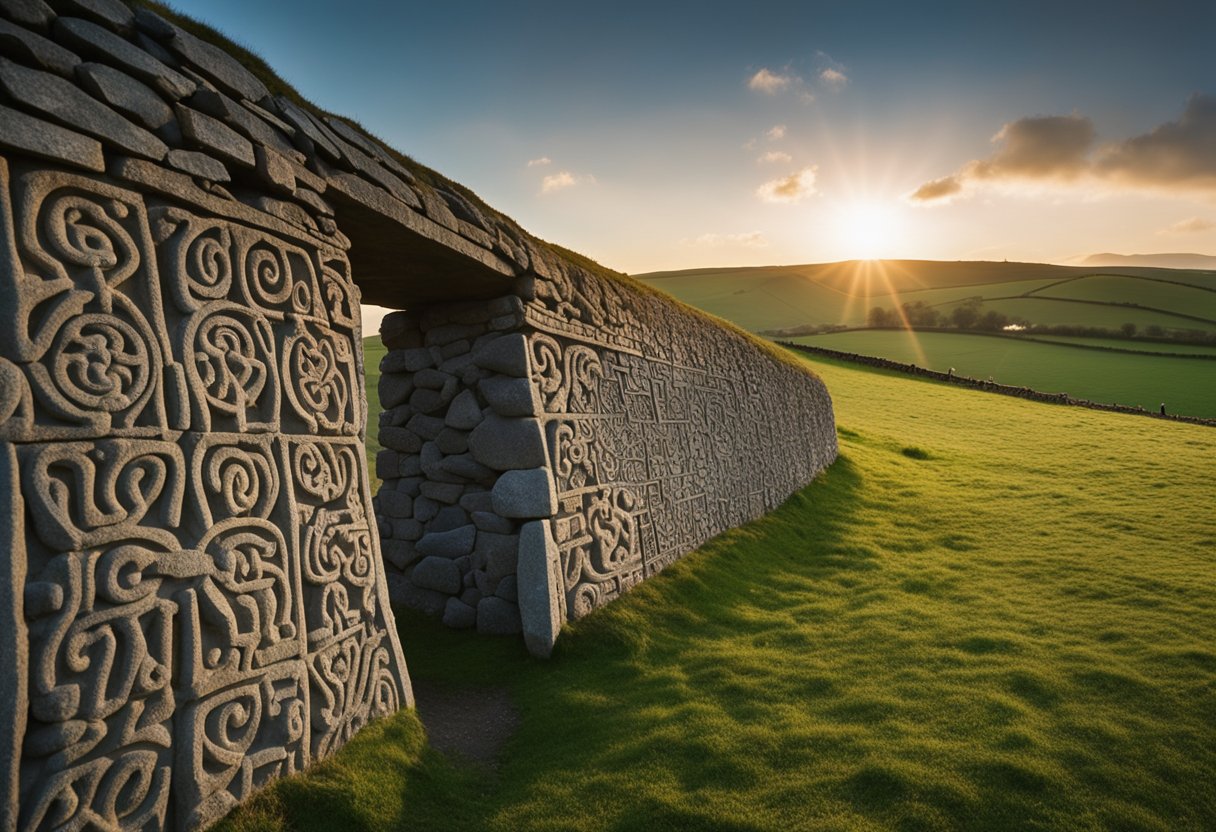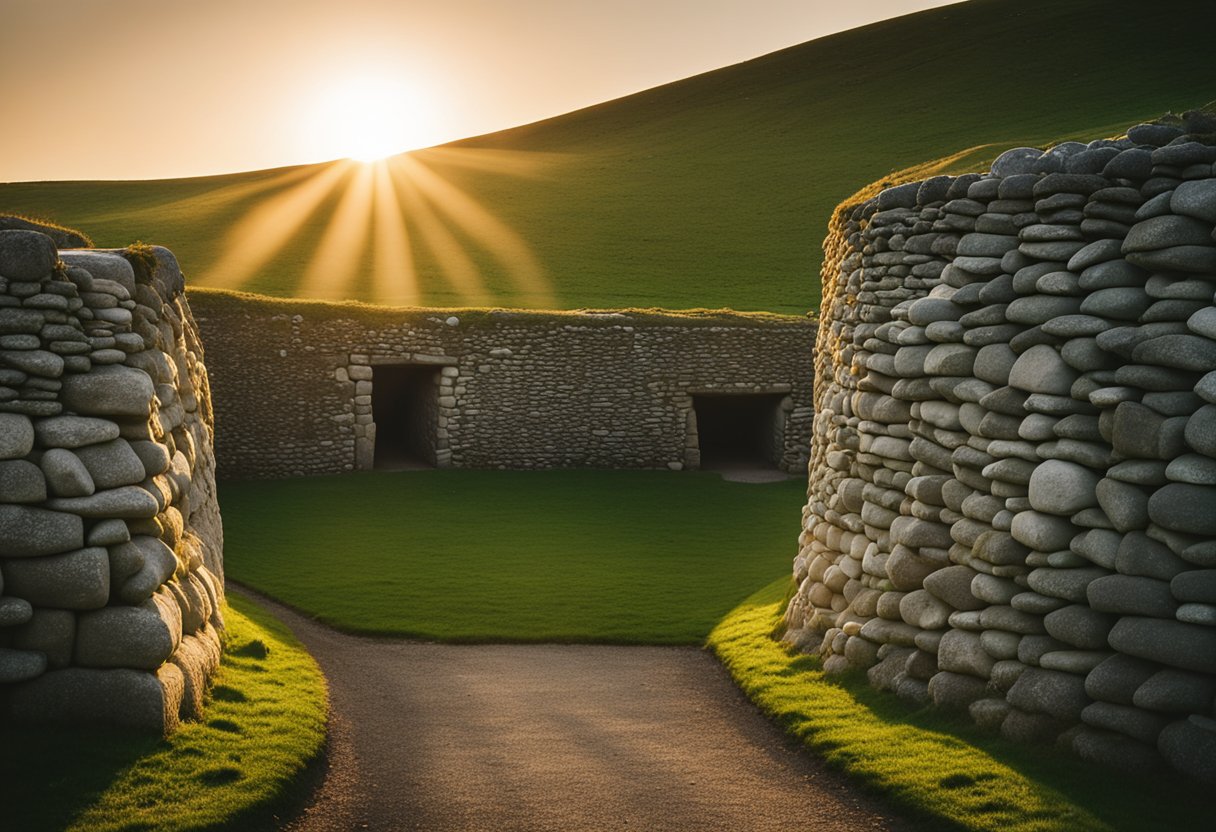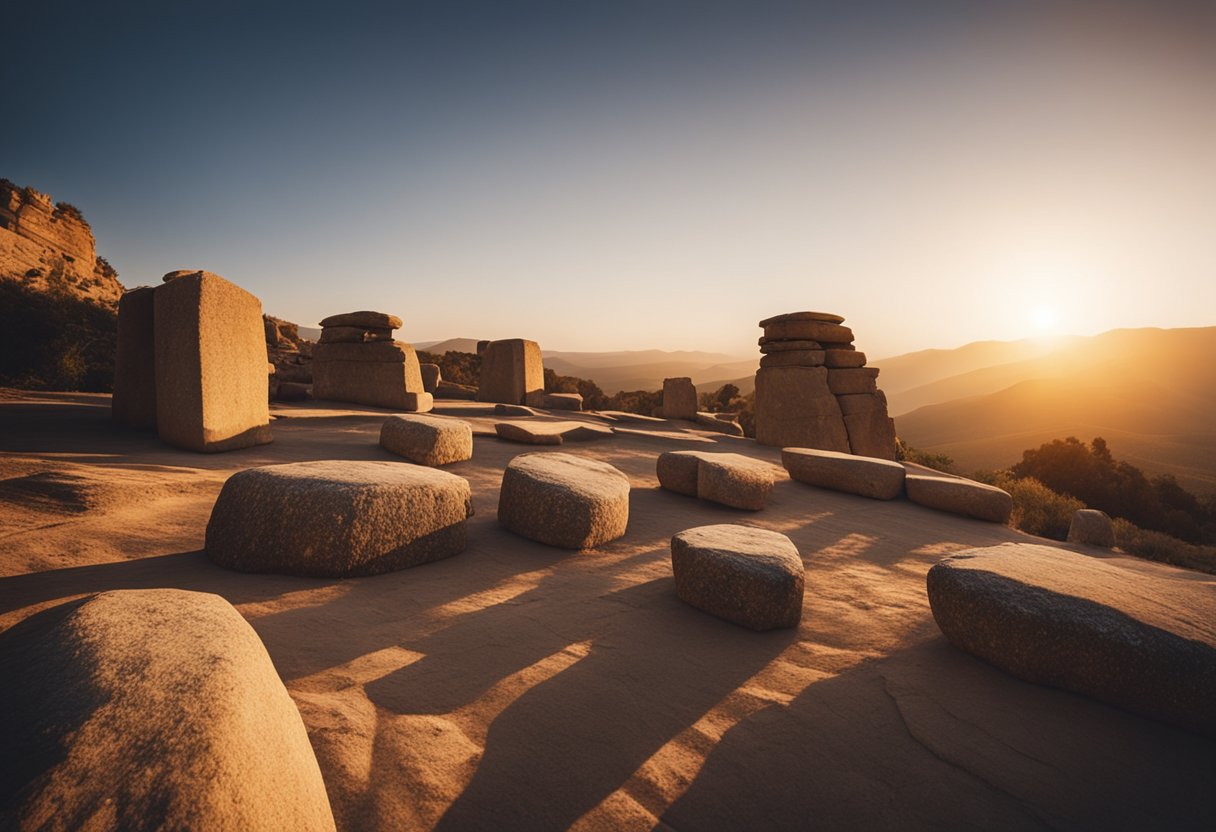Stars and Stones: Deciphering Newgrange’s Archaeo-Astronomical Secrets

Updated On: April 20, 2024 by Maha Yassin
In archaeoastronomy, ancient sites like Newgrange in Ireland offer profound insights into how past civilisations merged their understanding of astronomy with cultural and architectural practices. Our ancestors were keen observers of the celestial domain, and their astronomical knowledge is embedded in the very stones of structures such as Newgrange. Constructed over 5,000 years ago during the Neolithic period, this prehistoric monument exemplifies the sophistication with which ancient cultures aligned their constructs with astronomical events. At Newgrange, the winter solstice sunrise illuminates its inner chamber, a testament to the astronomical precision achieved by its builders.
This site is not only an archaeological treasure due to its age and preservation but also a significant case study in archaeoastronomy. Through Newgrange, we better understand the intertwining of daily life, ceremonial significance, and celestial phenomena in ancient times. It reveals that the stone-built passage tomb was more than a burial place; it was a canvas upon which Neolithic people recorded their astronomy. Our investigations into these sites go beyond simple curiosity; they allow us to piece together a broader sociocultural narrative that illustrates the importance of the stars in the worldview of ancient societies.
Fundamentals of Archaeoastronomy
In exploring the fundamentals of archaeoastronomy, we delve into how ancient peoples integrated celestial phenomena with their structures, revealing deep-seated connections between culture and the cosmos.
Conceptual Framework
As a discipline, archaeoastronomy sits at the crossroads where astronomy intersects with the human cultural experience. Its methods rely on understanding the science behind prehistoric monuments and their alignments with celestial bodies. This encompasses examining ancient artefacts, structures, and sites to infer how past cultures interpreted the night sky in their creativity and worldview.
Fundamental to this practice is the idea that many ancient constructions were purposefully aligned with astronomical events such as solstices, equinoxes, and lunar cycles. Through rigorous research and examination of sightlines, shadows, and light patterns within these sites, we can gain insights into the ideas and motivations behind prehistoric architecture.
Historical Development
The historical development of archaeoastronomy connects us to the scientific endeavours of scholars who’ve traced the evolution of this interdisciplinary field. Since its inception, the field has uncovered evidence of sophisticated astronomical knowledge in ancient cultures, from the Mayans to the Egyptians and Newgrange in Ireland.
The analysis of patterns of light and shadow during the winter solstice at Newgrange helped propel the historical development of archaeoastronomy. This Neolithic structure, meticulously aligned with the rising sun on the shortest day of the year, is a testament to the astronomical precision and significance of such sites in their respective societies.
By applying modern methods, including computer simulations and digital reconstructions, we continue to build upon the foundation laid down by earlier researchers. This allows us to untangle the complex narratives woven by our ancestors, in which the heavens above served as clock and calendar, guiding and informing their existence.
Newgrange: A Case Study
Newgrange stands as a testament to the sophisticated knowledge of astronomy and skilled architecture by the Neolithic people of Ireland. It intertwines architectural mastery and astronomical precision, setting a distinct example in ancient megalithic sites.
Architectural Analysis
We find that Newgrange is a marvel of Neolithic construction, showcasing remarkable sophistication. It was carefully crafted, utilising over 200,000 tonnes of rock, including water-rolled stones from the Irish Sea and large boulders transported from several kilometres away. The kerbstones that encircle the mound, decorated with megalithic art, underscore the ceremonial significance of the site. The corbelled roof of the inner chamber remains watertight to this day, an astonishing feat considering the passage tomb dates back over 5,000 years.
Within the main structure, the passage stretches for 19 metres, leading into a cruciform chamber, where one finds three recesses, each harbouring a large basin stone. These stones likely had a ritualistic function or were used for depositing the remains of the dead. The construction techniques evident at Newgrange achieved an enduring legacy and a profound connection to the celestial phenomena observed by its builders.
Astronomical Alignments
Fascinating aspects of Newgrange come to light when examining its astronomical alignments. It’s notably aligned with the rising sun during the winter solstice when sunlight illuminates the passage and chamber in a spellbinding event. This alignment is no mere coincidence but a clear indication of the importance of astronomy and the sacred landscape to the ancient people who built Newgrange.
Moreover, the interior of Newgrange is illuminated twice a year, not only at the winter solstice but also at the summer solstice, though to a lesser extent. This illustrates a sophisticated understanding of the stars and their cyclical patterns. Such architectural decisions reinforce the idea that Newgrange served as a powerful symbol within the Neolithic community, possibly marking the beginning of a new agricultural cycle or serving as a communal focal point for rites and ceremonies related to the cosmos.
Architectural Aspects of Ancient Constructions
Ancient constructions like Newgrange reflect an extraordinary intersection of architecture, celestial knowledge, and landscape. The builders of these ancient sites used stones to create formidable structures and infused them with significant purpose grounded in their understanding of astronomy.
Design and Purpose
The design of Newgrange is not accidental; it encapsulates a profound connection with the cosmos. The passage tomb is strategically aligned with the winter solstice, where sunlight permeates the inner chamber on the shortest days of the year. This design underscores a likely dual purpose: as a burial place and a ceremonial space for rituals linked to the yearly agricultural cycle and belief in an afterlife.
Building Techniques
Building techniques of the time relied heavily on the available materials and reflected a deep understanding of the landscape. Large stones, or megaliths, were transported over notable distances and carefully positioned. Dry-stone walling was also crucial; it involved fitting stones together without mortar, showcasing architectural understanding and a harmonious balance with the natural world.
The ingenuity behind these ancient constructions is a testament to their creators’ sophisticated knowledge and skill, allowing structures like Newgrange to remain standing millennia after their completion.
Celestial Observations in Ancient Times
In ancient times, meticulous night sky observations governed calendars and rituals, epitomised by the precision of structures like Newgrange in Ireland.
Apparent Motions
The apparent motion of celestial bodies across the sky was central to ancient astronomy. We observed that the stars move in a fixed pattern, while the sun, moon, and planets – the ‘wandering stars’ – follow more complex paths. This movement is due to Earth’s rotation and orbit around the sun. We developed celestial coordinates to map the sky, much like geographic coordinates on Earth. These systems allowed us to accurately track objects and predict their locations at any given time.
Observation Techniques
Our ancestors used various techniques to observe the heavens, often with impressive ingenuity. Large stone megaliths acted as astronomical observatories, aligning with significant celestial events. We used simple yet effective tools like gnomons – the earliest shadow clocks – to measure the sun’s position. This was critical for planning agricultural activities. Observations of the moon’s phases aided our understanding of time, and the planetary motions were meticulously charted, contributing to the development of predictive models in astronomy.
Mathematics and Astronomy

In examining the archaeo-astronomy of Newgrange, we find that precise mathematics and innovative astronomical software are integral to uncovering its secrets. We focus on how the ancient builders used mathematical calculations to predict astronomical events and how modern tools facilitate the study of these ancient sites.
Calculations and Predictions
A series of intricate calculations is at the heart of Newgrange’s alignment with the celestial bodies. Measurements of angles, distances, and geometric shapes were utilised to predict the winter solstice sunrise, which bathes the chamber in light. This feat of prehistoric engineering required an advanced understanding of mathematics and a deep knowledge of the cyclical patterns of the stars and the sun.
Astronomical Software Tools
Stellarium and other astronomical software have revolutionised how we study sites like Newgrange. By simulating the sky at different points in time, these tools allow for detailed analysis of ancient alignments without the need for physical presence at the site. We can confirm their astronomical purposes and refine our understanding of the site’s geographical positioning and relation to celestial events.
By marshalling mathematics and modern astronomical software, we deepen our comprehension of Newgrange — visualising the past and its celestial connections with clarity and certainty.
Sociocultural Influence of Astronomy

Astronomy’s impact on society is broad, influencing culture, religion, and power dynamics, particularly at ancient sites like Newgrange. It mirrors the civilisations’ understanding of the afterworld and the cosmos.
Religious and Ritual Significance
Newgrange, a prehistoric monument in Ireland, is a testament to its celestial significance for its creators. Constructed over 5,000 years ago, it aligns with the rising sun on the winter solstice, illuminating its inner chamber. This phenomenon suggests a profound religious and ceremonial importance, as the light may have symbolised the victory of life over death, a common theme in ancient cultures. The connection between this event and the afterworld might have represented a powerful symbol of rebirth and continuity for the society.
Astrology and Mythology
Astrology at Newgrange was intertwined with mythology. The site is steeped in Irish myths, with legends saying it was built by the Tuatha Dé Danann, a group of divine beings in Irish mythology who later became associated with historical kings and heroes. This intertwining of celestial observation with mythology underscores the site’s status in power narratives and cultural identity. The movement of celestial bodies was not merely an object of curiosity but a central element in the community’s stories, shaping their understanding of the cosmos and their place within it.
Global Perspectives on Archaeoastronomy

In exploring the global perspectives on archaeoastronomy, we uncover ancient civilisations’ celestial connections and structures, helping us understand their relationship with the skies.
Mediterranean Insights
In the Mediterranean, significant contributions to archaeoastronomy have been made by ancient cultures, including the Egyptians and Greeks. The pyramids of Egypt, aligned with precision to the cardinal points, are a testament to the advanced understanding of astronomy held by the ancient Egyptians. Similarly, Greek temples often aligned with celestial bodies, integrating cosmic order into their sacred architecture.
Worldwide Practices
Across the globe, ancient sites like Stonehenge in the UK and Chichen Itza in Mexico exhibit sophisticated astronomical alignments. The Incas of South America, in particular, left an impressive legacy with their careful observation of the sun, evident in sites like the Sun Temple of Machu Picchu. Ancient astronomers observed the stars and planets in Asia, influencing the placement and orientation of temples and monuments. These structures across continents reveal a common reverence for and intricate understanding of the cosmos, highlighting the universality of archaeoastronomy.
Scientific Methods in Archaeoastronomy

In our examination of archaeoastronomy, we’ll explore how scientific methods apply to the study of sites like Newgrange. These methods allow us to understand the interplay between celestial events and ancient structures.
Empirical Evidence Collection
Direct observation forms the foundation of empirical evidence collection in archaeoastronomy. When we investigate a site such as Newgrange, our initial step typically involves a site survey to record the position and orientation of the structures meticulously. We utilise magnetic compasses and inclinometers to ascertain the precise alignment of the site’s features. Global positioning systems (GPS) provide accurate coordinates, enhancing our understanding of the site within its geographical context.
Analytical Tools
Once we’ve compiled our empirical data, our analysis employs various analytical tools. The alt-azimuth coordinate system is particularly useful in determining how the site relates to the celestial sphere at certain times. Instruments like theodolites enable us to accurately measure horizontal and vertical angles, revealing how sites like Newgrange are oriented towards specific astronomical phenomena. Utilising these scientific methods, we can reconstruct the ancient sky and shed light on how past societies may have interpreted the stars and stones around them.
Interdisciplinary Approaches

In examining the archaeo-astronomy of Newgrange, we draw upon various disciplines to unravel the complex relationship between this ancient monument and the sky.
Integration with Archaeology
Our approach to understanding Newgrange’s link to celestial events is deeply rooted in archaeology. We meticulously analyse the physical layout and orientation of the site, which suggests a sophisticated knowledge of astronomical phenomena. By studying artefacts and structural alignments, we uncover how astronomical observations were integrated into the daily lives and spiritual practices of those who built and used Newgrange.
Contribution from Physics and Engineering
The contribution from physics and engineering is invaluable in our multidisciplinary analysis. Physics provides us with methods to track ancient celestial patterns, allowing us to simulate the sky as it would have appeared thousands of years ago. This helps us interpret alignments and artefact positioning within Newgrange. Engineering principles aid us in understanding the construction capabilities and technological sophistication of the builders, adding depth to our interpretation of this ancient site.
Throughout our study, we benefit from the rich insights found in texts published by Cambridge University Press and the interdisciplinary courses offered by institutions like the Politecnico di Milano, reinforcing our understanding of archaeo-astronomy as a truly multidisciplinary science.
Educational Sources and Literature
In this section, we explore pivotal educational sources and literature that offer insights into the archaeo-astronomy of Newgrange. These resources encompass rigorous academic publications as well as accessible online courses and tools, critical for both scholars and enthusiasts alike.
Academic Publications
The Cambridge University Press is a beacon of scholarly excellence, providing access to a wealth of academic publications on archaeo-astronomy. Within this domain, the works of Prof. Giulio Magli are essential readings. Magli’s contributions to the field, such as his investigations into archaeo-astronomical sites, are referenced in countless bibliographies and literature reviews.
The Nexus Network Journal, a peer-reviewed scholarly outlet, delves into architecture and mathematics, encompassing the interplay of structures and celestial alignments. It often includes articles by distinguished figures like Robert Hannah and Juan Antonio Belmonte, whose research elucidates the astronomical orientations of historical sites.
Online Courses and Resources
For those eager to expand their knowledge through structured learning, Coursera offers online courses covering a vast array of subjects, including archaeo-astronomy. Experts in the field craft these courses, which often include comprehensive references and up-to-date literature.
Moreover, Connolly Cove—with its rich heritage and now globally encompassing scope—serves as a platform where educational articles and resources on the world’s cultural and historical sites are curated. It provides articles and guides that can enhance one’s understanding of the importance of astronomical observations in ancient times and encourages a sustainable approach to exploring such timeless heritage sites.
All these resources maintain respect for copyright regulations, ensuring that creators and academics receive due credit for their work and that the knowledge is shared responsibly with the broader community.
Frequently Asked Questions
This section explores some of the most commonly asked questions surrounding Newgrange and its connection to archaeo-astronomy.
What are Newgrange’s foremost astronomical characteristics?
Newgrange is famed for its solar alignment, particularly its roof-box, which is uniquely positioned to catch the rays of the sunrise during the winter solstice. This event illuminates the chamber within, showcasing the sophistication of Neolithic engineering.
How did Stone Age societies align their monuments with celestial bodies?
Stone Age societies observed the sky and the movements of celestial bodies with great precision. Their alignment of monuments like Newgrange with astronomical events seems to rely on observational techniques and a deep understanding of cyclical patterns in the sky.
What is the significance of the white quartz stones found at Newgrange?
The white quartz stones that adorn Newgrange’s facade contribute to its visual impact and may have held ceremonial significance. Their bright appearance might symbolise rebirth or illumination, tying in with the sunrise during the winter solstice.
In what ways is Newgrange considered a unique prehistoric site?
Newgrange stands out due to its advanced age, dating back to around 3200 BCE, making it older than Stonehenge and the Great Pyramids of Giza. Its intricate design, precise alignment, and megalithic art render it a unique testament to Neolithic craftsmanship and cosmology.
How does Newgrange reflect the intersection of archaeology and astronomy?
Newgrange serves as an exemplary site where archaeology and astronomy converge. The precise alignment with the winter solstice sunrise and the placement of megaliths demonstrate a clear integration of structural design with astronomical observations.
What insights into Stone Age Ireland can we gain from the alignments at Newgrange?
The alignments at Newgrange allow us to glean insights into the societal importance of astronomy in Stone Age Ireland. They suggest a complex understanding of the seasons, time-keeping, and possibly a form of spirituality centred around the cosmos.






